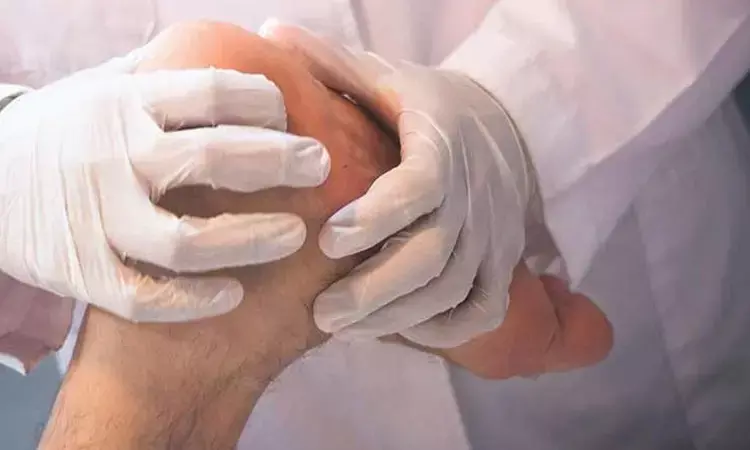- Home
- Medical news & Guidelines
- Anesthesiology
- Cardiology and CTVS
- Critical Care
- Dentistry
- Dermatology
- Diabetes and Endocrinology
- ENT
- Gastroenterology
- Medicine
- Nephrology
- Neurology
- Obstretics-Gynaecology
- Oncology
- Ophthalmology
- Orthopaedics
- Pediatrics-Neonatology
- Psychiatry
- Pulmonology
- Radiology
- Surgery
- Urology
- Laboratory Medicine
- Diet
- Nursing
- Paramedical
- Physiotherapy
- Health news
- Fact Check
- Bone Health Fact Check
- Brain Health Fact Check
- Cancer Related Fact Check
- Child Care Fact Check
- Dental and oral health fact check
- Diabetes and metabolic health fact check
- Diet and Nutrition Fact Check
- Eye and ENT Care Fact Check
- Fitness fact check
- Gut health fact check
- Heart health fact check
- Kidney health fact check
- Medical education fact check
- Men's health fact check
- Respiratory fact check
- Skin and hair care fact check
- Vaccine and Immunization fact check
- Women's health fact check
- AYUSH
- State News
- Andaman and Nicobar Islands
- Andhra Pradesh
- Arunachal Pradesh
- Assam
- Bihar
- Chandigarh
- Chattisgarh
- Dadra and Nagar Haveli
- Daman and Diu
- Delhi
- Goa
- Gujarat
- Haryana
- Himachal Pradesh
- Jammu & Kashmir
- Jharkhand
- Karnataka
- Kerala
- Ladakh
- Lakshadweep
- Madhya Pradesh
- Maharashtra
- Manipur
- Meghalaya
- Mizoram
- Nagaland
- Odisha
- Puducherry
- Punjab
- Rajasthan
- Sikkim
- Tamil Nadu
- Telangana
- Tripura
- Uttar Pradesh
- Uttrakhand
- West Bengal
- Medical Education
- Industry
Forefoot plantar pressure predicts re-ulceration risk in diabetics with previous amputation history

Spain: To predict the risk of re-ulceration in patients with previous forefoot amputation, analysis of barefoot pressures beneath the metatarsal heads should be done separately, suggests a recent study in Diabetes Research And Clinical Practice.
A one-year prospective study was conducted by Marta García-Madrid and a team from Spain to analyze a plantar pressure cut-off point for diabetic foot re-ulceration beneath the metatarsal heads in patients with previous forefoot amputation.
The study included a total of 105 patients at high risk for foot ulceration. Separate registration of peak plantar pressure (PPP) and pressure-time integral (PTI) in the entire foot, the forefoot region, and each metatarsal head was done. To select the optimal diagnostic pressure cut-off points, ROC curves were used. Follo-up of the patients was done on a monthly basis or until the development of an ulcer event.
The key findings of the study were as follows:
· A total of 52 (49.5%) patients developed a re-ulceration.
· Using ROC analyses for PPP in the full foot and in the forefoot, did not predict re-ulceration beneath the metatarsal heads.
· Analyzing separately each metatarsal head of all patients with values greater than or equal to 20.8 N/cm2 at the 1st, 18.62 N/cm2 for the 2nd, 18.85 at the 3rd, 17.88 at the 4th, and 12.2 at the 5th metatarsal heads will suffer a re-ulceration despite the use of orthopedic treatment with optimum values of sensitivity (from 100 to 87.5) and specificity (from 83.2 to 62.8).
The researchers concluded by saying that "separate analysis of barefoot pressures beneath the metatarsal heads should be done to predict the region at risk of re-ulceration."
About diabetic foot ulcers
Diabetic foot ulcers are among the most common complications of diabetes which are not well controlled. It results from underlying neuropathy, poor glycemic control, poor foot care, or peripheral vascular disease. It can lead to osteomyelitis of the foot and amputation of the lower extremities. These ulcers are usually in the areas of the foot that encounter repetitive trauma and pressure sensations.
Reference:
The study titled, "Predictive value of forefoot plantar pressure to predict reulceration in patients at high risk," appears in Diabetes Research And Clinical Practice.
DOI: https://doi.org/10.1016/j.diabres.2022.109976
Dr Kamal Kant Kohli-MBBS, DTCD- a chest specialist with more than 30 years of practice and a flair for writing clinical articles, Dr Kamal Kant Kohli joined Medical Dialogues as a Chief Editor of Medical News. Besides writing articles, as an editor, he proofreads and verifies all the medical content published on Medical Dialogues including those coming from journals, studies,medical conferences,guidelines etc. Email: drkohli@medicaldialogues.in. Contact no. 011-43720751


